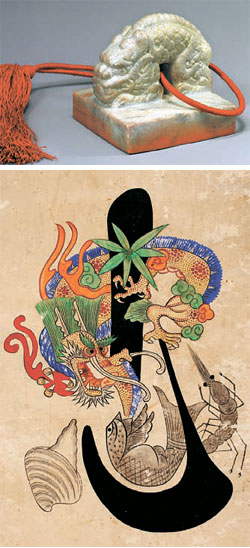Move over rabbit, make way for Year of the Dragon

The National Folk Museum, located in Gyeongbok Palace in central Seoul, is holding the “Special Exhibition: The Year of the Dragon” to mark the launch of the new year.
The exhibit that opened earlier this month and is set to continue until Feb. 27 displays 85 artifacts of the mythical creature, including drawings, ceramics, furniture, seals, flags and royal robes.
The dragon is a legendary beast bearing all the strengths of several animals: the head of a camel, antlers of a deer, eyes of a rabbit, ears of a cow, neck of a snake, scales of a carp, talons of a hawk and the feet of a tiger.
Those characteristics led people to believe the dragon to be the mightiest animal.
The dragon, therefore, symbolized power, authority and sanctity, eventually coming to represent the position of the king in the Chinese and Korean royal courts.
The exhibition displays a Korean king’s dragon royal robe, dragon throne, and other furniture and fixtures decorated with the legendary beast to symbolize the king’s courage and power.
In Korea, the dragon pattern once dominated by the royal court appeared later in the clothing and furniture of ordinary working-class people.
Such working-class artifacts will also be on display for visitors of the exhibition.
The exhibition also has pictures depicting the dragon’s image of “future” and “hope” as in many Korean colloquial expressions and proverbs.
One such expression is “Like a dragon from a ditch,” a proverb referring to a great person born from a poor or humble household, since dragons are born from big bodies of water including oceans and rivers, according to folk beliefs in Korea.
Several drawings and a wooden pencil case embodied the Korean expression “Deungyongmun (Going up Yongmun)” originated from a Chinese legend that a carp can turn into a dragon if it succeeds in going up rapids in a canyon called Yongmun in the upper stream of the Yellow River in China.
Dragons are perceived as the rulers of the sea or water.
Korean farmers would pray to dragons for rain during long droughts while fishermen would perform rituals dedicated to the “Dragon King” when they headed out to sea for fishing or traveling and launched their vessels for the first time.
The exhibit also displays large farming tools related to such folk beliefs and pictures portraying the Dragon King.
Yonhap










with the Korea JoongAng Daily
To write comments, please log in to one of the accounts.
Standards Board Policy (0/250자)